

 Vol. 38 (Nº 62) Year 2017. Páge 8
Vol. 38 (Nº 62) Year 2017. Páge 8
Kairat BODAUKHAN 1; Maira Shakibaevna BAUER 2; Botagoz Bulatovna BERMUKHAMBETOVA 3; Zhanerke KOCHIIGIT 4; Saule Tolegenovna OKUTAYEVA 5
Received: 06/10/2017 • Approved: 20/10/2017
ABSTRACT: The diaspora policy pursued by the Republic of Kazakhstan is aimed at preserving the ethnic identity and national identity of Kazakhs living abroad and has an important strategic importance within the country's migration policy. The purpose of the study is to develop scientifically based recommendations on the attraction of ethnic migrants in the rural areas of the Republic of Kazakhstan for work. Research methods include a survey of ethnic migrants living in rural areas of the Akmola region; the development of an econometric model and the analysis of empirical data. As a result of the study, key sustained factors affecting the employment of ethnic migrants in agriculture have been revealed; the main barriers in the development of farming enterprises by ethnic migrants have been identified; the problems faced by migrants have been justified; recommendations on the adaptation of migrants in the Republic of Kazakhstan have been proposed. |
RESUMEN: La política de la diáspora que persigue la República de Kazajstán tiene como objetivo preservar la identidad étnica y la identidad nacional de los kazajos que viven en el extranjero y tiene una importancia estratégica importante dentro de la política de migración del país. El propósito del estudio es desarrollar recomendaciones basadas en la ciencia sobre la atracción de los inmigrantes étnicos en las áreas rurales de la República de Kazajstán para el trabajo. Los métodos de investigación incluyen una encuesta de inmigrantes étnicos que viven en áreas rurales de la región de Akmola; el desarrollo de un modelo econométrico y el análisis de datos empíricos. Como resultado del estudio, se han revelado los principales factores sostenidos que afectan el empleo de inmigrantes étnicos en la agricultura; se han identificado las principales barreras en el desarrollo de las empresas agrícolas por parte de los migrantes étnicos; los problemas que enfrentan los migrantes se han justificado; se han propuesto recomendaciones sobre la adaptación de los migrantes en la República de Kazajstán. |
In conditions of the crisis demographic situation in the country, a diaspora can be an additional human resource in the Republic of Kazakhstan. In the modern conditions of integration and globalization, the Kazakh diaspora can become an important component of the foreign policy and foreign economic policy of the country. After the collapse of the Soviet Union, in Kazakhstan there was a negative balance of migration that negatively affected the country's economy. After gaining sovereignty, several million people were involved in internal and external migration. Thus, according to the report of the American Pew Research Center on religion and public life, since the collapse of the Soviet Union 89% of Kazakhstan migrants moved to Europe, their number was 3,710 million people, 350 thousand people emigrated to the Asia-Pacific region and 30 thousand (less than 1%) moved to the USA and the countries of the Middle East (Tanaeva 2012). It should be noted that immigration has a significant influence on stabilizing the demographic situation in the country. For instance, about 1.0 million ethnic Kazakhs returned to the republic during the years of independence. More than half of them had agricultural education and skills. As of the first half of 2016, a share of the rural population of Kazakhstan was 7.6 million people, i.e. 43% of the total population (The Agency of Statistics of the Republic of Kazakhstan, n.d.).
More than 90% of ethnic migrants settle in rural areas, but due to the lack of targeted programs and low attractiveness of agriculture, they move from place to place in search of work. According to the survey conducted by members of the research team among ethnic migrants, 65.7% of ethnic migrants burden the situation with internal migration, moving to cities in search of means of living Nurly Kosh State Program for the period of 2009-2011, 2008).
A tendency of a decrease in the rural population, and an increase in the number of residents of non-working age significantly weakened the social base, which can ensure the success of rural reforms. In this regard, the study of modern migration processes, the analysis of the scale, directions and determining factors, as well as the identification of various aspects of the impact of migration on the state of agriculture are rather relevant.
The regional study of the quantitative and qualitative characteristics of current migration flows oriented to the countryside, an impact of migrants on the labor market emerging in the agrarian sphere, as well as the processes of adaptation of settlers in places of their settlement, are of great interest to the authors of the study.
In Kazakhstan, various government bodies implement various programs aimed at regulating migration processes (annual Presidential Decree on the Approval of the Immigration Quota, State Migration Program, Nurly-Kosh program) (2008).
However, as indicated above, these programs could not fully achieve the set goal. The weak identification of specific measures for the effective implementation was a reason; at the same time, the tasks and measures of the programs did not meet the expectations of the target group. The state program Nurly-Kosh was aimed at regulating migration processes and the demographic situation in the country, taking into account the capabilities of the host countries and expectations of ethnic migrants; it was suspended a year after the start of the implementation. This program was criticized by the President and repatriated Kazakhs-beneficiaries due to the shortcomings and inefficient spending of budget funds, and was suspended in 2011.
In connection with the foregoing, the identified conditions necessary for ethnic migrants living in agricultural regions will be compared with the measures envisaged in the various programs and strategies, which will allow assessing the effectiveness of the instruments used and their potential to solve the problem.
Despite labor-consuming studies of migration in Kazakhstan ((Tätimov, 1986; Tätimov, 1999; Ğalï, 2003; Vishnevskii, 1998; Rakisheva, 2006; Rakisheva, 2006; Mustafayev, n.d.; Mustafayev, 2011; Sadovskaya, 2006; Mukhitdenova, & Kim, 2012; Mamontova 2013; Molodikova 2003), ethnic migration has not been adequately considered through the prism of the values, motives, mental and cultural characteristics of ethnic migrants. Besides, an impact of ethnic migrants on the development of the country's economy, in particular on the agrarian sector, has not been studied. The peculiarities and methods of the attraction of ethnic migrants with the experience and skills of doing agricultural business in the development of the agribusiness industry have not been studied.
Due to the existence of an unexplored niche of ethnic migration in Kazakhstan, this study aims to conduct a sociological analysis of ethnic migrants living in rural areas of the Akmola region, as well as to study the goals and reasons for moving to the historical homeland, to identify barriers and problems in adaptation, to determine the degree of integration with the local population, to study the degree of motivation and desire to work in the agribusiness industry. In addition, research objectives include considering the awareness of the repatriated Kazakhs of the measures of state support of the agribusiness industry and identifying the main deterrents of the development of one’s own business in the agribusiness industry.
The methodological and theoretical basis for the development of the project included the works of foreign and Kazakhstan scientists devoted to the problems of ethnic migration (Tätimov, 1986; Tätimov, 1999; Ğalï, 2003; Vishnevskii, 1998; Rakisheva, 2006; Rakisheva, 2006; Mustafayev, n.d.; Mustafayev, 2011; Sadovskaya, 2006; Mukhitdenova, & Kim, 2012; Mamontova 2013; Molodikova 2003; Sluka, 2006; Germany Sees Immigration Boom, 2014; Zhetesova 2007; Shuraeva 2009; Delovarova 2013; Heller 1975; Messamore 2004; Andirenko, & Guriev 2006; Münz 2006). The methodological basis included a systematic and integrated approach to the object and subject studied.
Most of the studies of Russian and Kazakhstan scientists specializing in this issue are devoted to the internal migration processes in Kazakhstan, the urbanization and the outflow of the rural population; special attention is paid to the emigration of ethnic minorities – "brain drain". In addition, studies on the mechanisms of the economic integration of repatriated Kazakhs in Kazakhstan society, an impact of migration on the regional cooperation have been conducted; a statistical analysis of the migration of the population of the Republic of Kazakhstan has been performed.
Despite this, ethnic migration has not been sufficiently considered through the prism of the values, motives, mental and cultural characteristics of ethnic migrants. An impact of ethnic migrants on the development of the country's economy, in particular on the agrarian sector, has also not been studied.
In the study, the methodical section has been developed in the following areas:
1. The studied set of respondents of the scientific project has been determined. The general totality is made up of ethnic migrants. The selection totality is made up of 15% of the total number of ethnic migrants living in the territory of the Akmola region. Independent variables include the duration of stay in Kazakhstan, the level of education, types of work.
2. The directions and topics of sociological research on the study of the status of ethnic migrants and the identification of conditions for their involvement in agriculture have been formulated. For example:
- determination of conditions and the quality of life of ethnic migrants;
- identification of common problems of ethnic migrants concerning the employment and employment factors in agriculture.
3. The main goals of sociological research have been defined:
- to identify the main reasons for moving to the historical homeland,
- to determine the level and quality of social benefits of ethnic migrants in the framework of the resettlement program,
- to establish the level of accessibility and the degree of development of the socio-cultural infrastructure in places of current residence,
- to reveal the degree of accessibility to social, medical and educational services,
- to reveal the main directions of socio-economic and cultural-psychological adaptation and emerging problems,
- to find out the main sources and the level of income,
- to describe the main forms and types of employment, its compliance with education, professional qualifications, professional and work experience,
- to identify the main causes of unemployment,
- to determine the degree and forms of employment in agriculture,
- to reveal the reasons for the desire to work in agriculture,
- to identify the reasons for the reluctance to work in agriculture,
- to determine the hierarchy of conditions conducive to the desire to work in agriculture.
4. The tasks, forms and stages of sociological research have been established.
5. The selection totality of respondents has been determined.
6. A method of information collection and the sequence of application of tools have been established.
As for the topics of sociological surveys, questions used in the survey of respondents were developed; they included 29 closed-ended and 2 opened-ended questions (in Kazakh and Russian). Using these questions, a pilot study was conducted with the purpose of studying conditions and the quality of life of ethnic migrants, as well as common problems of their employment and employment factors in agriculture. Ethnic migrants were an object of the study. The selection totality of the study included 23 respondents. Research results showed the need for reformulation of questions on financial standing of repatriated Kazakhs due to the sensitivity of the question and the reluctance of respondents to share the information. The pilot study confirmed the need for further study of this problem. Therefore, the selective totality of respondents of the repeated sociological survey has been determined.
In the framework of the developed scientific and methodological basis, the members of the scientific project continued their research work at the local level. In order to obtain initial information from repatriates, as well as to confirm hypotheses, business trips were organized to the following settlements in the Akmola region: Bulandy, Egindykol, Astrakhanka, Shortandy, Arkalyk, Amangeldy, Elizavetinka, Zhaksy, Yesil, Arshaly, Ereimentau, Derzhavinsk, Atbasar.
In order to obtain the statistical data on repatriated Kazakhs living in the Akmola region, a business trip to the city of Kokshetau was made and a meeting with the employees of the regional administration was organized.
In the study, the following hypotheses have been put forward:
1. Are repatriated Kazakhs satisfied with the quality of life in rural areas?
2. Are repatriated Kazakhs living in rural areas interested in working in agriculture? If so, why. If not, why.
3. Has the quality of life of repatriated Kazakhs improved after moving to the historical homeland?
It should be noted that a method of "snowball" sampling satisfied the expectations of the research group and proved to be effective, but, at the same time, it was costly in terms of time resources. Unfortunately, local and district administrations did not have up-to-date data on the number of repatriates residing at the local level and forms of their activities. In this regard, by using the "snowball" method the research team managed to question 321 repatriates living in rural areas of the Akmola region. It also should be noted that primary studies on the attitude of repatriated Kazakhs to agriculture, their trust in the authorities, their relations with the local population, satisfaction with the life in the historical homeland, the degree of adaptation and their patriotic spirit have not been conducted. Therefore, this study will make a significant contribution to the study of repatriated Kazakhs.
Some problems mentioned by repatriated Kazakhs in the study are similar to those of indigenous Kazakhs living in rural areas. Common problems include the poor quality of education in rural schools, dissatisfaction with the quality of medical services, undeveloped rural infrastructure, the lack of awareness of state support programs, difficulty in collecting documents for participation in favorable credit facilities.
According to the statistical data received from the Ministry of Labor and Social Protection of the Population of the Republic of Kazakhstan, for the period from 1991 till present Kazakhstan has accepted more than 952 thousand ethnic migrants, which is 5.5% of the total population of the Republic of Kazakhstan (Ministry of Labor and Social Protection of Population, n.d.).
It should be noted that ethnic migrants from Uzbekistan (61.5%) are over-represented in the number of all arrived ethnic migrants. Figure 1 shows the structure of migration flows to the republic by countries.
Figure 1
The structure of migrants by countries
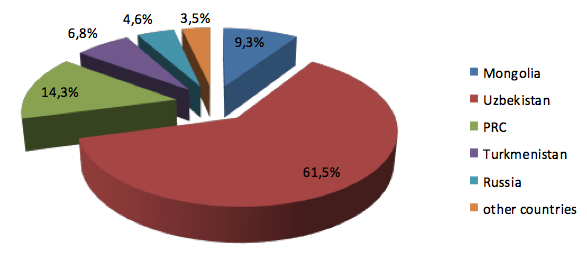
Thus, the number of repatriates from the People’s Republic of China (PRC) is 14.3% of the total number of migrants, from Mongolia – 9.3%, from Turkmenistan and Russia – 6.8% and 4.6%, respectively. The share of immigrants from such countries as Turkey, Iran, Afghanistan and others is 3.5% (Ministry of Labor and Social Protection of Population, n.d.).
It should be noted that livestock breeding is widespread among ethnic Kazakhs living in Mongolia and the PRC. At the same time, repatriated Kazakhs, who arrived from these countries, face obstacles in the adaptation and integration into new society due to the language barrier and cultural and mental differences. On the contrary, repatriated Kazakhs from Russia and Uzbekistan quickly adapt to the realities of Kazakhstan thanks to the common Soviet past and the knowledge of the Russian language. The largest concentration of ethnic migrants is observed in the South-Kazakhstan region (21.2%), Almaty region (16.3%), Zhambyl region (9.4%); the remaining 41% of the arrived ethnic migrants settled in 11 regions of Kazakhstan and in the cities of republican significance. There is a significant decline in ethnic immigration to Kazakhstan. For example, according to the data of the Ministry of Health and Social Development of the Republic of Kazakhstan, shown in Figure 2, the dynamics of the flow of ethnic migrants have decreased since the beginning of 2012. In the context of five-year periods, the flow of ethnic migration to Kazakhstan has decreased from 32.2% in the period of 2007-2011 to 8.3% in the period from 2012 till present (Figure 2).
Figure 2
The dynamics of the flow of ethnic migrants
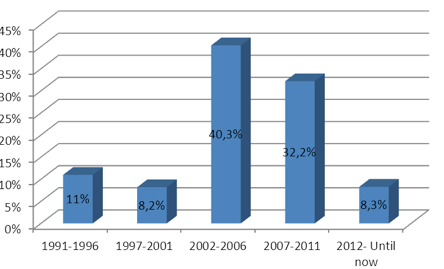
In order to obtain primary quantitative data at the initial stages of the study, the working team developed questionnaires for respondents. About 423 repatriates living in rural areas of the Akmola region took part in the survey.
According to the results of the survey, the earliest immigration happened in 1991 immediately after gaining independence. The latest repatriates moved to Kazakhstan in 2010. As is known, since 2012 after the abolition of the quota for repatriated Kazakhs there has been a significant decline in ethnic migration.
According to the preliminary data obtained in the survey in the Akmola region, 86% of the respondents are natives of Mongolia, while only 14% of the surveyed repatriated Kazakhs came from Uzbekistan. The average age of the respondents is 42.3 years old; the youngest respondent is 27 years old, the eldest respondent is 54 years old. Women are in the prevailing majority of respondents (77%), the proportion of men in the sample is only 23%. This can be explained by the fact that mostly by nature it is easier to find women at home, they are more responsive and talkative.
As for education of repatriates, the questionnaire survey showed that 57% of repatriated Kazakhs living in the territory of the Akmola region had secondary education, 36% of respondents had secondary vocational education and only 7% of respondents had higher education (Figure 3).
Figure 3
The level of respondents’ education
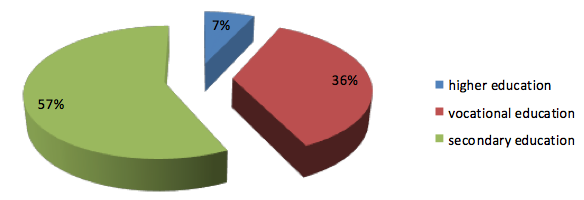
According to the results of the initial questionnaire, 62.4% of respondents thought that their family's social and economic quality of life had improved after moving to their historical homeland, 18.8% of respondents thought that the quality of their life remained at the same level, and 18.8% of respondents thought that the quality of their life had become worse (Figure 4).
Figure 4
The assessment of changes in the quality of life after moving

Nevertheless, 94% of the surveyed repatriates did not want to return to their former homeland, 76% of the respondents did not want to leave their current place of residence.
Besides, 87% of the respondents did not have difficulties in communicating with the local population and were on good terms with Kazakh-speaking and Russian-speaking neighbors.
However, as for significant difficulties in adapting to a new place of residence, 32% of respondents identified the problems associated with bureaucracy, 21% of respondents noted difficulties in finding a job, 11% of respondents had difficulties due to the lack of knowledge of the Russian language (Figure 5).
Figure 5
Difficulties after moving
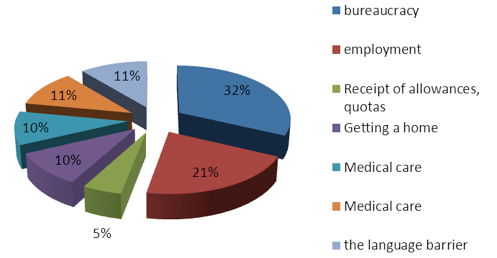
According to the data obtained, 55% of the surveyed repatriates were self-employed in the sphere of agriculture (Figure 6). However, it should be noted that most of them had small farms in order to provide food to themselves and their families, and only for 37.5% of respondents this type of activity was a source of basic income.
Figure 6
Sectors of employment of respondents
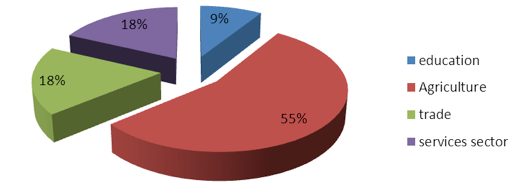
Figure 7 shows the types of repatriates’ income. Thus, 12.5% of respondents had relatives (spouse, children) working in the city and sending money. Besides, most of the 37.5% of respondents, who had a source of income in the form of a fixed salary, worked in the city or also had relatives working in the city (Figure 7).
Figure 7
The main source of income
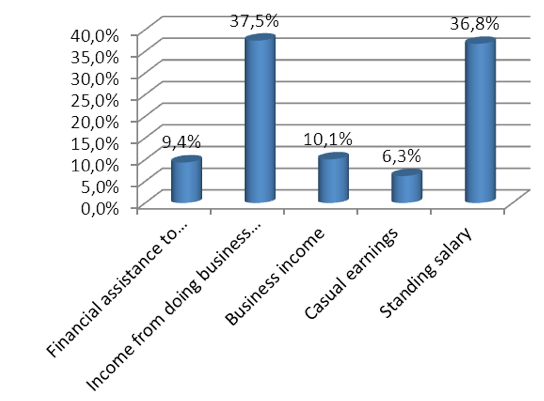
Only 6% of respondents benefited from the programs of support for the development of the agribusiness industry; in particular, they benefited from soft loans for the purchase of equipment and an increase in the number of livestock. The remaining 94% of respondents were either not interested in extending their farms at all or not informed of possible ways of getting state support. Besides, they were afraid and avoided possible credit risks.
Figure 8
Reasons restricting the work in agriculture
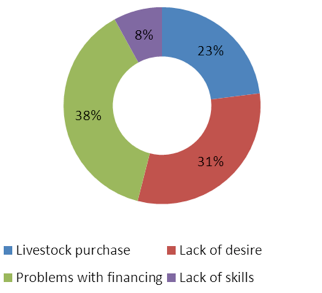
The respondents noted the following reasons that impeded the work in agriculture (Figure 8): the problems with financing, agricultural lending (38% of respondents), the lack of desire to practice agriculture (31% of respondents), and the problems arising from the livestock purchase (23% of respondents).
An econometric model has been developed to identify steady variables affecting the employment of ethnic migrants in agriculture.
The econometric research model considers the age of a respondent as a predictive variable in connection with the global trend of demographic "aging" of farmers. It is assumed that the younger the respondent is, the less likely the economic activity of the respondent is connected with farming.
According to the research of American scientists, the place of residence of people directly affects their lifestyle (Danzer 2011; Danzer & Ivaschenko 2010; Binswanger & Deininger 1997; Binswanger & Deininger 1997). Thus, people living near markets, public transport stops and city parks keep more active lifestyle than others. However, according to some scientists, nowadays a farmer does not have to live in rural areas to be engaged in agriculture. In practice, there are many examples when an urban entrepreneur purchases land in rural areas and, without changing familiar surroundings, carries out farming activities, engaging labor on site, if necessary. Based on this practice, in the econometric model the place of residence of a respondent is a predictive variable that does not affect employment in agriculture. Thus, villagers and residents of district centers are equally involved or not involved in agriculture.
Empirical scientific works of many foreign authors (Jamison, & Lau, 1982; Jamison, & Moock, 1984; Lau, & Yotopoulos, 1971; Lockheed, Jamison, & Lau, 1980; Monke, & Pearson 1989; Phillips, 1994; Randall, 1987; Reinhard, Lovell, & Thijssen, 2000; Bidlack, 2015; Rosegrant, & Cline, 2003; Tauer 1995; Tilman, Cassman, Matson, Naylor, & Polasky, 2002; Azhigalis, 2013; Volchik, 2010; Libman, 2013; Shmakov, 2016; Faith on the Move. The Religious Affiliation of International Migrants, 2012) such as Phillips (1994), Jamison (1982, 1984), Lockheed (1980) and Haque (2013) state that there is a direct positive connection between the level of education of a farmer and the efficiency of his/her activities. It means that the higher the farmer's education is, the more efficient his/her activities are. However, according to the Kazakhstan expert in the sphere of international migration, E. Sadovskaya (2006), during the years of independence Kazakhstan lost its ethnic diversity formed by the mid-1980s, when agriculture made up a third of the GDP of the Kazakh Soviet Socialistic Republic. After the emigration of qualified agricultural specialists – they were 10 thousand people with higher agricultural education – Kazakhstan began to experience notable difficulties in agriculture: the area of arable land, harvests, labor productivity in the industry decreased. As a result, despite the employment of 28% of the population in agriculture, today the contribution of this sector to the country's GDP makes up only 4%. Consequently, in this study the authors suggest that the education of a respondent negatively affects his/her employment in agriculture. It means that a respondent with secondary vocational and higher education is more likely to be employed in hired labor.
It is assumed that satisfaction with the rural way of life and awareness of the programs of state support of the agribusiness industry also positively influence predictive variables. The professional activity performed before moving is also a resultant variable.
The model of econometric data processing is based on the probit regression model for predicting the probability of involving a respondent in agriculture by values of a set of characteristics, for example, a country of departure, profession, education, age, former professional activity, etc.
Thus,

Figure 9
Graph of a dependent variable

A dependent variable (Figure 9) in this model is "the involvement in agriculture" of a respondent – {y}, which takes on one of two values – numbers 0 (a respondent does not practice agriculture) and 1 (agriculture is the main source of income of a respondent), and independent predictive variables {X1, X2,...,Xn}, (Xage, Xplace of residence, Xcountry of departure, … Xn.), the values of which are needed for the calculation of the probability of taking on a certain value of the dependent variable {y} (age, place of residence, country of departure, etc.).
Consequently, the econometric research model is as follows:

The analysis of the empirical data has been carried out on the basis of the STATA 12 software, the Probit regression model.
Hypotheses of this study suggest the following:
1) The elder a respondent is, the more likely he/she is involved in the agribusiness industry;
2) The place of residence of a respondent (village, district center) does not affect the employment in agriculture;
3) Repatriates from Mongolia and China are more adapted to agriculture.
Table 1 shows regression results.
Table 1
Regression results
Indicators |
(1)
|
(2) |
(3) |
Place of residence |
- |
-1.4397*** (.3489) |
-2.8589*** (.7347) |
Education |
-0.5352* (.3193) |
-0.5648** (.2613) |
-0.6085** (.2821) |
Age |
0.9297*** (.1946) |
0.1129*** (.5407) |
0.1056 (0.3379) |
Age2 |
-0.0094*** (.0021) |
-0.0011*** (.0001) |
-0.0013 (.0002) |
Country of departure |
0.3662 (.3112) |
0.2996 (.2368) |
0.2364 (2464) |
Previous profession |
-0.1564 (.1426) |
-0.0321 (.1132) |
0.0767 (.1271) |
State program |
0.5827 (.4225) |
- |
-.2068 (.3756) |
Satisfaction with the rural way of life |
0.1972 ( .2732) |
- |
1.2544*** (.2263)
|
Constant |
-22.3758 (4.7929) |
1.0511 (.6276) |
-1.8887 (1.4203) |
Number of observations |
124 |
124 |
124 |
Pseudo R2 |
0.6671 |
0.5104 |
0.5749 |
Loglikelihood |
-26.197094 |
-38.5282 |
-33.4567 |
Prob > chi2 |
0.0062 |
0.0000 |
0.0000 |
Note – Robust standard deviations of the coefficients are given in brackets *p < 0.1, **p < 0.05, ***p < 0.01 |
|||
The econometric analysis shows that the main factors explaining the employment of ethnic migrants in agriculture are as follows: the place of residence, the level of education, age and satisfaction with the rural way of life. Besides, according to regression results, the coefficients of education and place of residence are negative. Thus, the conclusion is that mainly middle-aged ethnic migrants, who have the level of education lower than secondary vocational education, live in rural areas and do not want to change their place of residence in the immediate future (which is confirmed by their satisfaction with the rural way of life), are engaged in agriculture of the Akmola region.
The data of the econometric analysis confirm the hypothesis that mainly ethnic migrants of an average age of 44.7 years old work in the agricultural sector. This is explained by the fact that younger ethnic migrants prefer hired labor in the city, if possible, or in the district center. Thus, the analysis revealed that the average age of ethnic migrants employed in the agribusiness industry is 44.7 years old. It is assumed that in general the average age of the population of the Republic of Kazakhstan employed in agriculture is at the same level. It should be noted that this indicator is a positive fact for Kazakhstan, while the average age of farmers in the world increases significantly. Kazakhstan has the potential to develop the agribusiness industry in the context of the current relatively favorable demographic situation.
However, the study shows that the level of education of ethnic migrants working in the agribusiness industry is lower than the secondary vocational education, which causes low labor productivity for the agricultural sector as a whole. 28% of the population employed in the agribusiness industry produces only 4% of the country's GDP. This issue requires careful consideration, since the strategic plans of the government of the Republic of Kazakhstan on structural transformation of the economy consider the agribusiness industry as one of the leading drivers of economic growth.
A hypothesis suggesting that the place of residence of a respondent (village, district center) does not affect the employment in agriculture has not been confirmed. A predictive variable assessing the place of residence of respondents showed high stability (p < 0.01). Thus, it follows that ethnic migrants, who live in rural areas, not in district centers, are more often employed in the agribusiness industry. This can be explained by the fact that in the district center the possibility of obtaining farming land is less likely. However, respondents' responses show a relatively equal attitude to the problem of the land plot. Thus, 16 respondents living in the village and 19 respondents living in the regional center noted the lack of the possibility of obtaining farming land as the main barrier.
The authors' assumption that repatriates from Mongolia and PRC are more adapted to agriculture has not been confirmed. The predictive variable that measures this factor proved to be unstable. Thus, the country of departure of ethnic migrants is not a determining factor in their employment in the agribusiness industry.
In general, it should be noted that the empirical analysis of primary data shows the main factors affecting employment in the agribusiness industry are education, place of residence, age. However, according to the results, we can assume that employment in the agribusiness industry is not a motivated decision of the respondents, but rather the only possible variant of the economic activity.
The quantitative method is not always the only method of sociological research and some controversial issues remain in the exceptional application of this method. In this regard, at the second stage of research in-depth qualitative studies were conducted through the arrangement of meetings of focus groups and in-depth interviews of farmers-repatriated Kazakhs. The goal of the focus group was to conduct an "in-depth focused group interview" to disclose the attitudes and beliefs of ethnic migrants. A focus group method was used for describing and understanding a phenomenon, but not for extrapolating the conclusions to major social communities. Each focus group consisted of 15 respondents living in localities near the regional center of the Akmola region. Thus, 30 repatriated Kazakhs employed in agriculture were invited to participate in the focus group meeting. 23 of them were engaged in farming at personal subsidiary farms; 5 people were employed in hired labor in farms and 2 people had their own farms. 54% of focus group members were residents of the Zerendinsky district, 17% – of the Burabay district, and 29% – of the Enbekshildersky district.
The purpose of discussion of focus groups was to identify the following issues:
• Is the employment of ethnic migrants in the agribusiness industry more likely a condition, in which they appeared, than their conscious decision?
• Are they actually satisfied with the rural way of life and do not want to change their place of residence, according to the empirical data?
• What do ethnic migrants employed in the agribusiness industry think of the state support of agribusiness?
• Do state programs actually not motivate them to work in the agribusiness industry as shown by the econometric model?
• What kind of administrative barriers in the agribusiness industry currently impede the employment of ethnic migrants in the agribusiness industry?
The identification of the main problems faced by repatriated Kazakhs was a result of the meetings of focus groups. The main problems identified were as follows:
- the lack of socially important facilities, such as schools, pre-school educational institutions;
- the lack of social assistance;
- the minimum pension that did not correspond to the length of employment;
- not all the settlers were provided with the housing and the housing of those who obtained it did not meet the state standard requirements.
The authors’ empirical findings that the employment in agriculture is rather the last possible employment option have been confirmed. For example, in focus group meetings some respondents confirmed that at first they tried to find a profitable job in nearby industrial enterprises, farming companies or farms; however, one of the following conditions was unacceptable for them: either working conditions or salary, and the only possible way to earn money was to work at personal subsidiary farms.
Ethnic migrants self-employed in agriculture were mainly engaged in cattle breeding. However, the scale of farm household was limited due to the lack of pastures and land for the preparation of forage (haymaking).
The most acute farming problems stated by focus group participants are as follows:
- there are no land allotments for the organization of farms;
- there is no start-up capital, no collateral for obtaining a loan, no social capital and means of social mobility.
After moving, some ethnic migrants completed retraining courses, having trained as a plumber, locksmith, electrician, machinist, cook, etc. However, they could not find a job in a new profession either, so they run their personal subsidiary farms as the only guaranteed source of small but stable income. Besides, according to respondents, farming labor intensity was very high, which made agriculture not attractive for young people, and the benefit from labor was very low. It should be noted that the problems stated by the respondents are most likely reflected in the general republican situation of the agribusiness industry.
The factors that negatively affect the adaptation of ethnic migrants in the Republic of Kazakhstan are as follows:
Agentstvo po statistike Respubliki Kazakhstan [The Agency of Statistics of the Republic of Kazakhstan]. (n.d.). Retrieved August 18, 2017, from www.stat.gov.kz
Andirenko, Yu., & Guriev, S. (2006). Analiz migratsii v Rossii [Analysis of Migration in Russia]. Series Analiticheskie otchety i razrabotki [Analytical Reports and Developments], No. 23. Moscow: Center for Economic and Financial Research and Developments at the Russian Economic School.
Azhigalis, E. (2013). Ekspeditsiya etnologov v Altaiskuyu avtonomnuyu oblast i Sintszyan-Uigurskii avtonomnyi raion (Suar) KNR [Expedition of Ethnologists to the Altai Autonomous Region and Xinjiang Uygur Autonomous Region (Suar) of the PRC]. Retrieved August 18, 2017, from
Bidlack, R. (2015). Russia and Eurasia 2015-2016 (pp. 138-139). Rowman & Littlefield.
Binswanger, H.P., & Deininger, K. (1997). Explaining Agricultural and Agrarian Policies in Developing Countries. Journal of Economic Literature, 35(4).
Danzer, A.M. (2011). Economic Benefits of Facilitating the Integration of Immigrants, CESifo DICE Report. Journal for Institutional Comparisons, 9(4), 14-19.
Danzer, A.M., & Ivaschenko, O. (2010). Migration Patterns in a Remittances Dependent Economy. Evidence from the Global Financial Crisis. Migration Letters, 7(2), 190-202.
Delovarova, L. (2013). Vliyanie migratsii na ustoichivoe razvitie v TsA (kazakhstanskii kontekst): diss... doktora filosofii [Influence of Migration on Sustainable Development in Central Asia (Kazakhstan Context) (Doctoral Thesis)]. Moscow.
Denisenko, M.B., Kharaeva, O.A., & Chudinovskikh, O.S. (2003). Immigratsionnaya politika v Rossiiskoi Federatsii i stranakh Zapada [Immigration Policy in the Russian Federation and Western Countries]. Moscow.
Faith on the Move. The Religious Affiliation of International Migrants. (2012, March 8). Retrieved August 18, 2017, from http://www.pewforum.org/2012/03/08/religious-migration-exec/
Ğalï, Ä. (2003). Köbeymesek kösegemiz kögermeydi. Qazaqstan baspa üyi.
Germany Sees Immigration Boom. (2014). German Mission in the United States. Retrieved August 18, 2017, from http://www.germany.info/V...012/11/15Immigration.html
Gosudarstvennaya programma "Nurly kosh" na 2009-2011 gody [Nurly Kosh State Program for the period of 2009-2011]. (2008, December 2). Approved by the Decree of the Government of the Republic of Kazakhstan No. 1126.
Heller, C.S. (1975). Ethnic Differentiation among the Jews of Israel. In Migration and Development: Implications for Ethnic Identity and Political Conflict (pp. 97-113). Mouton & Co.
http://e-history.kz/ru/contents/view/478/
Jamison, D.T., & Lau, L.J. (1982). Farmer Education and Farm Efficiency. World Bank; Johns Hopkins University Press.
Jamison, D.T., & Moock, P.R. (1984). Farmer Education and Farm Efficiency in Nepal: The Role of Schooling, Extension Services and Cognitive Skills. World Development, 12(1), 67-86.
Lau, L.J., & Yotopoulos, P.A. (1971). A Test for Relative Efficiency and Applications to Indian Agriculture. The American Economic Review, 61(1), pp. 94-109.
Libman, A.M. (2013). Sotsialnyi liberalizm, obshchestvennyi interes i povedencheskaya ekonomika [Social Liberalism, Public Interest and Behavioral Economics]. Obshchestvennye nauki i sovremennost, 1, 28-39.
Lockheed, M.E., Jamison, T., & Lau, L.J. (1980). Farmer Education and Farm Efficiency: A Survey. Economic Development and Cultural Change, 29(1), 37‑76.
Mahmudul, H.A.Z., Ishida, A., & Taniguchi, K. (2003). The Role of Farmer Education on Income in Bangladesh. Bulletin of Education and Research Center for Lifelong Learning, Shimane University, 2, 29-35.
Mamontova, E.A. (2013). Osobennosti sovremennoi migratsionnoi situatsii v Rossii [Features of the Current Migration Situation in Russia]. Voprosy sovremennoi nauki i praktiki, S44, 76-80.
Messamore, B.J. (2004). Canada and Migration: Kinship with the World. In Canadian Migration Patterns: from Britain and North America. Ottawa: University of Ottawa Press.
Ministerstvo truda i sotsial'noi zashchity naseleniya [Ministry of Labor and Social Protection of Population]. (n.d.). Astana. Retrieved August 18, 2017, from http://www.enbek.gov.kz/ru
Molodikova, I. (2003). Osnovnye etapy i metody regulirovaniya trudovoi migratsii [The Main Stages and Methods of Regulating Labor Migration]. In Zh.A. Zayonchkovskaya (Ed.), Trudovaya migratsiya v SNG: sotsialnye i ekonomicheskie effekty [Labor Migration in the CIS: Social and Economic Effects]. Moscow. (p. 288).
Monke, E.A., & Pearson, S.R. (1989). The Policy Analysis Matrix for Agricultural Development. Ithaca: Cornell University Press.
Mukhitdenova, A.T., & Kim, L.M. (2012). Nekotorye aspekty migratsionnoi politiki Germanii [Some Aspects of the Migration Policy of Germany]. Vestnik KazNU, 3.
Münz, R. (2006). Migration, Labor Markets, and Integration of Migrants: An Overview for Europe. Social Protection Discussion Paper No. 0807. World Bank.
Mustafayev, N. (2011). Neobkhodima novaya diasporalnaya strategiya [A New Diaspora Strategy Is Needed]. ZONAkz.
Mustafayev, N. (n.d.). Migratsionnaya situatsiya v Kazakhstane [Migration Situation in Kazakhstan]. Retrieved August 18, 2017, from https://www.zakon.kz/66494-migracionnaja-situacija-v-kazakhstane.html
Phillips, J.M. (1994). Farmer Education and Farmer Efficiency: A Meta-Analysis. Economic Development and Cultural Change, 43(1), 149-165.
Rakisheva, B.I. (2006). Migratsionnye protsessy v Kazakhstane: faktor gosudarstvennoi politiki [Migration Processes in Kazakhstan: Public Policy Factor]. Institute for Social Comparative Research.
Randall, A. (1987). Resource Economics. New York.
Reinhard, S., Lovell, C.K., & Thijssen, G.J. (2000). Environmental Efficiency with Multiple Environmentally Detrimental Variables; Estimated with SFA and DEA. European Journal of Operational Research, 121(2), 287-303.
Rosegrant, M.W., & Cline, S.A. (2003). Global Food Security: Challenges and Policies. Science, 302(5652).
Sadovskaya, E. (2006). Sovremennaya migratsionnaya situatsiya v Kazakhstane: novye vyzovy, novye resheniya [Modern Migration Situation in Kazakhstan: New Challenges, New Solutions]. Baiterek, 2, 72-80.
Shmakov, A.V. (2016). Kompleksnoe predstavlenie ob ekonomicheskom povedenii [Comprehensive Idea of Economic Behavior]. Vestnik NSUEM, 2, 276-291.
Shuraeva, S.N. (2009). Statisticheskii analiz migratsii naseleniya Respubliki Kazakhstan: diss. ... kandidata ekonomicheskikh nauk [Statistical Analysis of Migration of the Population of the Republic of Kazakhstan (Ph.D. Thesis)]. Moscow.
Sluka, N.A. (2006). Urbanisticheskaya panorama mira na poroge XXI veka [Urban Panorama of the World on the Turn of the 21st Century]. Vestnik Moskovskogo Universiteta, 2, 7-12.
Tanaeva, L. (2012, April 3). Iz Kazakhstana uekhalo 4 milliona 150 tysyach chelovek [4 Million 150 Thousand People Left Kazakhstan]. Retrieved August 18, 2017, from https://rus.azattyq.org/a/migration_kazakh_religion/24534807.html
Tätimov, M. (1986). Awıldağı demografïyalıq axwal. Almaty.
Tätimov, M. (1999). Qazaqstannıñ derbes demografïyalıq sayasatın qalıptastırw. Almaty: Atamura.
Tauer, L. (1995). Age and Farmer Productivity. Review of Agricultural Economics, 17(1), 63-69.
Tilman, D., Cassman, K.G., Matson, P.A., Naylor, R., & Polasky, S. (2002). Agricultural Sustainability and Intensive Production Practices. Nature, 418(6898), 671-677.
Vishnevskii, A. (1998). Postsovetskoe demograficheskoe prostranstvo: Vostochnaya Evropa ili integrativnaya chast Evropy [Post-Soviet Demographic Space: Eastern Europe or an Integrative Part of Europe]. Mirovaya ekonomika i mezhdunarodnye otnosheniya, 5, 122-127.
Volchik, V.V. (2010). Povedencheskaya ekonomika i sovremennye tendentsii evolyutsii instituta sobstvennosti [Behavioral Economics and Contemporary Tendencies in Evolution of Property Institution]. Terra Economicus, 8(2).
Zhetesova, M. (2007). Mekhanizm ekonomicheskoi integratsii oralmanov v kazakhstanskoe obshchestvo: diss. ... kandidata ekonomicheskikh nauk [Mechanism of Economic Integration of Repatriated Kazakhs into Kazakh Society (Ph.D. Thesis)]. Almaty.
1. Saken Seifullin Kazakh Agrotechnical University , Republic of Kazakhstan
2. Saken Seifullin Kazakh Agrotechnical University , Republic of Kazakhstan
3. Saken Seifullin Kazakh Agrotechnical University , Republic of Kazakhstan
4. Saken Seifullin Kazakh Agrotechnical University , Republic of Kazakhstan
5. Saken Seifullin Kazakh Agrotechnical University, Republic of Kazakhstan, E-mail: saulesha_okutaeva@mail.ru